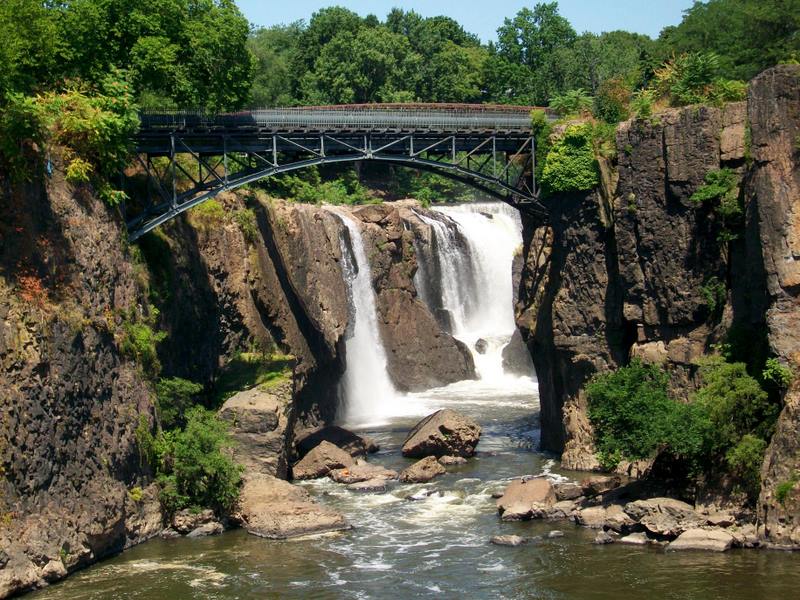Niagara may get most of the attention, but when it comes to New York-area waterfalls, it’s not alone. About 20 miles from NYC, as the Passaic River flows through Paterson, NJ, lie the Great Falls — the second-highest fall on the East Coast and one of the most important sites in America’s early industrial development.
It was at this site in 1791 that Alexander Hamilton helped found the Society for Establishing Useful Manufactures (S.U.M.), an early iteration of the public-private partnership. The next year, the town of Paterson was born as America’s first pre-planned industrial city. After a brief attempt at direct factory operation, the S.U.M found it much more lucrative to lease the land around the falls to other manufacturing concerns, selling them energy generated by the falls’ average daily flow rate of 2 billion gallons. Converted to electricity production in 1910, the hydroelectric station located adjacent to the fall achieved a productive capacity of up to 33 million kilowatts per year, and still provides electricity to ¼ of Paterson’s population.
 View of S.U.M. hydroelectric plant from elevated side of Great Falls.
View of S.U.M. hydroelectric plant from elevated side of Great Falls.
 Side view of the S.U.M.’s still-functional hydroelectric plant
Side view of the S.U.M.’s still-functional hydroelectric plant
To enhance the falls’ industrial capacity, a series of raceways opened in 1794. Based on initial designs by Pierre L’Enfant (who would later design the new nation’s capital), 3 tiers of raceways were eventually constructed; these canals harnessed the falls’ rapidly moving water to provide power to mills not directly located on the river. The raceways allowed the area to thrive as a hub of textile manufacturing; between Paterson’s founding in 1792 and 1820, the city saw an increase in population of over 900%.
 Lower Raceway between Mill and Market Streets
Lower Raceway between Mill and Market Streets
 Overgrown vegetation has taken the place of rushing water in the falls’ raceways. Walkways extending along much of their routes serve to connect visitors with the area’s history.
Overgrown vegetation has taken the place of rushing water in the falls’ raceways. Walkways extending along much of their routes serve to connect visitors with the area’s history.
One key concentration of early mills and factories is today known as the Allied Textile Printing (ATP) site, a 7.5 acre section of the district named after a textile company formed in the 1930s. Located directly upon the Passaic, this tract is home to the remains of the Patent Arms Manufacturing Company’s Gun Mill, which produced the first Colt revolving handguns. The A.T.P. site also contains remnants of several other textile and machine shops that were heavily damaged by fires in the 1980s.
 Remaining vestiges of the Allied Textile Printing Site; this complex contains the ruins of Samuel Colt’s Gun Mill, which produced Colt firearms from 1836 to 1842.
Remaining vestiges of the Allied Textile Printing Site; this complex contains the ruins of Samuel Colt’s Gun Mill, which produced Colt firearms from 1836 to 1842.
As economic changes altered the nation’s manufacturing landscape, Paterson was able to adapt — for a while. From its early focus on cotton and textiles, the area around the Great Falls evolved into a major center of steel and heavy industry by the 1860s. Falls-area factories produced the engine that propelled The Spirit of St. Louis around the world, locomotives that dug the Panama Canal, and served as the assembly point and testing site of the world’s first modern submarine.
Today, little remains of Paterson’s industrial capacity; less than 4% of Passaic County residents work in the manufacturing sector. The S.U.M. properties were purchased by the City in 1945; the 89-acre area was designated a National Historic Landmark district in 1976 and a New Jersey State Park in 2004. In 2009, legislation was signed inducting the district into the National Park system. Due to concerns over industrial contamination, the National Park’s boundaries — which are still being negotiated — may not include the A.T.P. site, leaving it potentially vulnerable to future development. Preservationists successfully defeated a proposal to bring townhouse development to the site earlier this decade, but riverside development pressures will continue to threaten the area if park designation cannot be secured.
Still, the district’s fortunes appear brighter than at any point in recent decades. The S.U.M. power plant is currently undergoing renovation, and the National Park designation has brought in new publicity and federal preservation funds. Some of the most endangered structures have been stabilized, and local preservationists hope that historical tourism can help lift the city’s sagging fortunes. Paterson is easily accessed from NYC via NJ Transit bus #190. For more information on the area’s history, visit www.patersongreatfalls.org.
 Keystone of the S.U.M.-constructed Passaic Street Bridge, built in 1850.
Keystone of the S.U.M.-constructed Passaic Street Bridge, built in 1850.
 Dam constructed by the S.U.M. in 1838 to control raceway and power station water levels.
Dam constructed by the S.U.M. in 1838 to control raceway and power station water levels.
 Remnants of water flow equipment along the lower raceway leading into the A.T.P. site.
Remnants of water flow equipment along the lower raceway leading into the A.T.P. site.
 The restored Rogers Locomotive factory, now home to the Paterson Museum.
The restored Rogers Locomotive factory, now home to the Paterson Museum.
 Gatehouse for the northern section of the raceway, now hosting an advertisement for local institution Libby’s Lunch.
Gatehouse for the northern section of the raceway, now hosting an advertisement for local institution Libby’s Lunch.
 The 1865 Ivanhoe Wheelhouse, located along the spillway between the middle and lower raceways. The wheelhouse once provided power for the Ivanhoe Paper Manufacturing Company.
The 1865 Ivanhoe Wheelhouse, located along the spillway between the middle and lower raceways. The wheelhouse once provided power for the Ivanhoe Paper Manufacturing Company.










